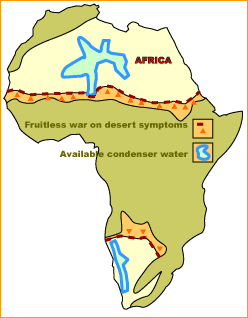Archive for February 2008
Sand Dams
Daily Motion Video on sand dams.
Grass lands eliminated toxic dust storms.
Dr. Karl L. Wuensch’s brief dust storm blurb.
Big Water and Grass – Africa
Biosolid application methods and design factors
Commentary by Mr. Luc Gnacadja, Executive Secretary of the United Nations Convention to Combat Desertification on the occasion of The TICAD IV Breakout session D: Addressing environmental issues/ climate change
29 May 2008, Yokohama, Japan
It is an honour for me to contribute to the work of this session.
Desertification means land degradation caused by various factors including climatic variations and human activities. According to the report of the Millennium Ecosystem Assessment, climate change is aggravating desertification, making it “the greatest environmental challenge of our times and a major impediment to meeting basic human needs in drylands.” In the Africa region, the issue is of serious concern, given that some 60 per cent of the population depends on agriculture and the land degradation processes affect about 46 per cent of the whole continent.
UNEP estimates that desertification costs some 9 billion US dollars a year in Africa alone. Further, a recent study indicated that land degradation on arable land is taking place in the most productive areas of sub-Saharan Africa, threatening food production in the long-run.
This already grim situation has been aggravated recently due to the sharp rise of food prices. It is striking that the geography of endemic poverty and hunger coincides with that of degraded lands. In fact, “today’s global challenges such as the food crisis, the consequences of biofuels on land and food commodities, the water scarcity, the forced migrations and other threats of climate change, are bringing the global community down to earth, down to the land. They are calling for sound and integrated policies including on sustainable land management”. I want to highlight that “reforming policies to combat desertification also represents one of the world’s most expedient ways to sequester more atmospheric carbon and help address the climate change issue” according to the UNU. So at the UNCCD, the UNMEA in charge of monitoring the sustainable management of land, we are calling for actions on the following:
1. Reject the notion that aridity and water scarcity are inevitable;
2. Create financial incentives for pastoralists and other dryland users to preserve and enhance the ecosystem services their land provides to all;
3. Accept the carbon sequestration as a measure for simultaneously combating desertification and climate change;
4. Foster alternative, sustainable livelihoods for dryland dwellers, including non-agricultural jobs;
5. Yield ownership and decision making to communities: empower them to take charge of land on which they depend and end the pattern of individuals chasing environmentally detrimental short-term gains;
Uranium and grass
Bacillus subtilis, sometimes called Grass Bacillus is a common soil bacteria.
Abstract
We assessed the accumulation of uranium (VI) by a bacterium, Bacillus subtilis, suspended in a slurry of kaolinite clay, to elucidate the role of microbes on the mobility of U(VI). Various mixtures of bacteria and the koalinite were exposed to solutions of 8 × 10− 6 M- and 4 × 10− 4 M-U(VI) in 0.01 M NaCl at pH 4.7. After 48 h, the mixtures were separated from the solutions by centrifugation, and treated with a 1 M CH3COOK for 24 h to determine the associations of U within the mixture. The mixture exposed to 4 × 10− 4 M U was analyzed by transmission electron microscope (TEM) equipped with EDS. The accumulation of U by the mixture increased with an increase in the amount of B. subtilis cells present at both U concentrations. Treatment of kaolinite with CH3COOK, removed approximately 80% of the associated uranium. However, in the presence of B. subtilis the amount of U removed was much less. TEM–EDS analysis confirmed that most of the U removed from solution was associated with B. subtilis. XANES analysis of the oxidation state of uranium associated with B. subtilis, kaolinite, and with the mixture containing both revealed that it was present as U(VI). These results suggest that the bacteria have a higher affinity for U than the kaolinite clay mineral under the experimental conditions tested, and that they can immobilize significant amounts of uranium. http://www.sciencedirect.com/science?_ob=ArticleURL&_udi=B6V5Y-4G7JXVH-3&_user=10&_rdoc=1&_fmt=&_orig=
search&_sort=d&view=c&_acct=C000050221&_version
=1&_urlVersion =0&_userid=10&md5=6e64f8f35f45d1e83b330bf7cbd1f6b5http://www.blackwell-synergy.com/doi/abs/10.1111/j.1747-5457.1994.tb00150.x
Mineralogical studies of Tertiary subsurface sediments in the Niger Delta have shown that smectite, kaolinite, <!–more–>
Big Water and Grass – Africa
Biosolid application methods and design factors
The Drought Myth
The Drought Myth
An Absence of Water is Not the Problem
Reprinted from Acres USA
November 2000 – Vol. 30, No. 11 – Cover Story
by William A. Albrecht, Ph.D.<!–more–>
.
Soil nutrients are essential!
Biosolid application methods and design factors
